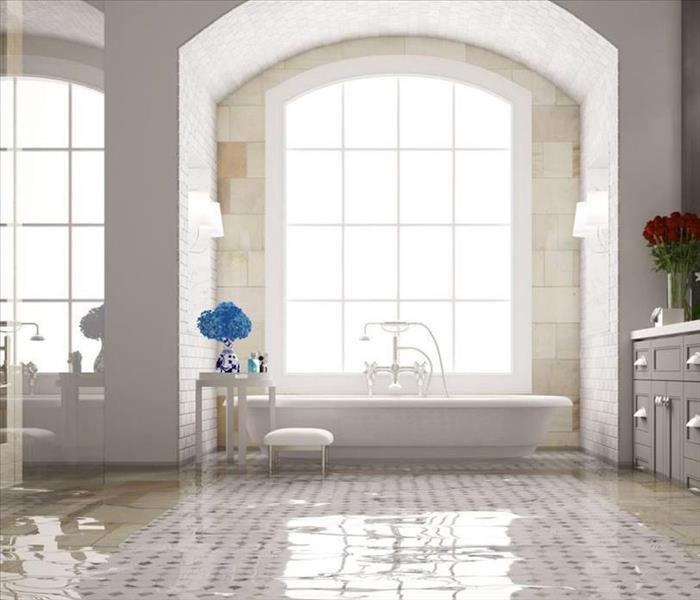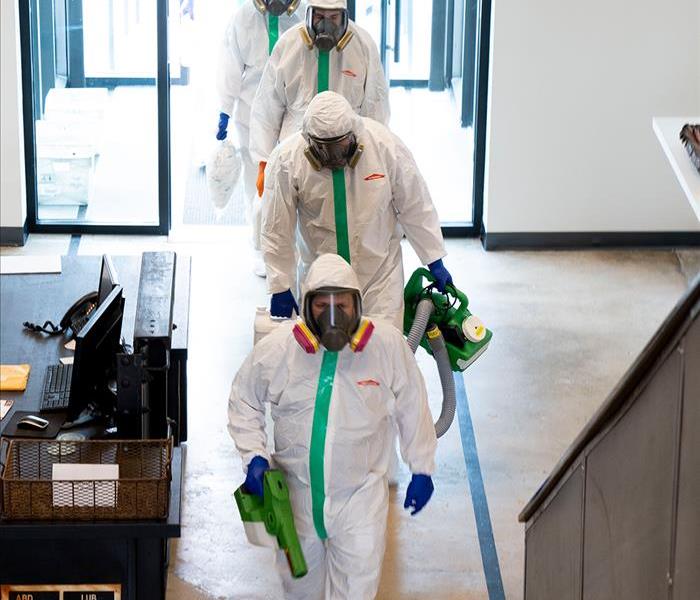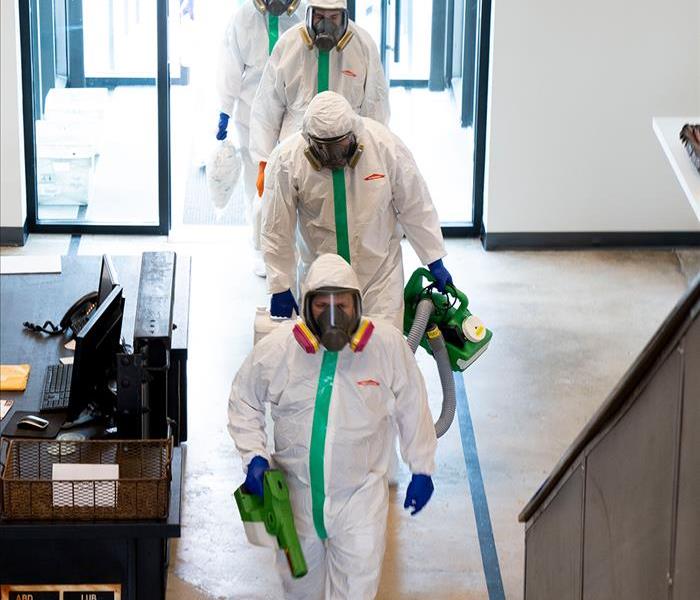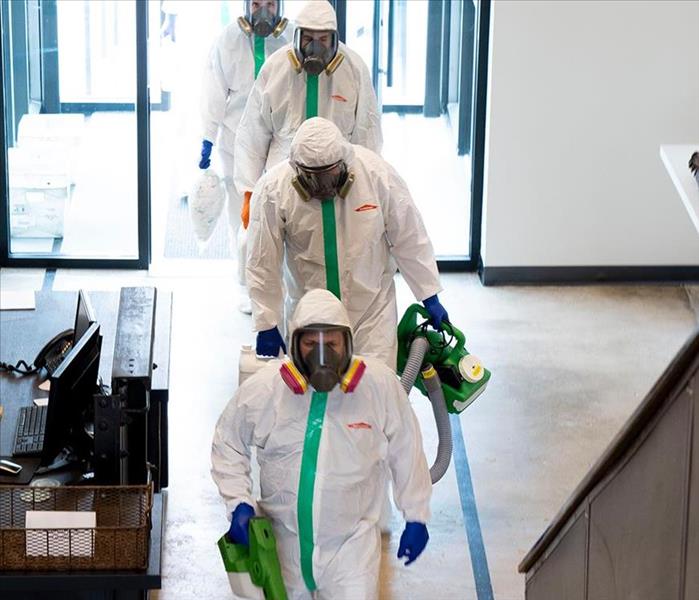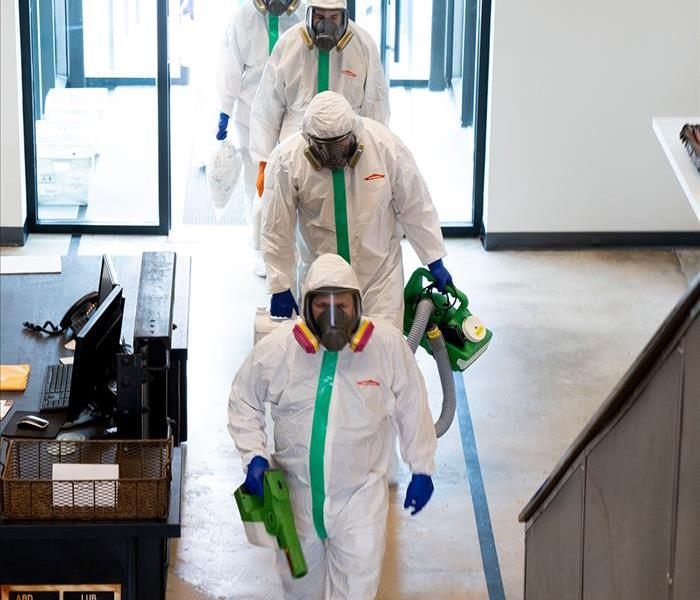Recent Posts
Why Choose SERVPRO® of Tulsa Hills/Sapulpa?
8/7/2024 (Permalink)
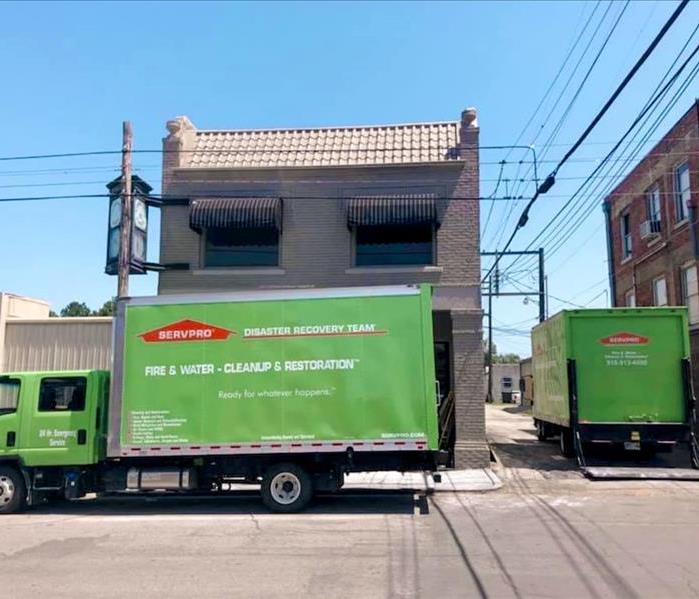 SERVPRO® vehicles on the job at a commercial building in downtown.
SERVPRO® vehicles on the job at a commercial building in downtown.
When disaster strikes your property, you need a restoration service you can trust to get the job done right. SERVPRO of Tulsa Hills/Sapulpa is the premier choice for fire, water, and mold damage restoration. Here’s why:
Unmatched Expertise and Training
At SERVPRO of Tulsa Hills/Sapulpa, our technicians are highly trained and certified in property damage restoration. We receive ongoing training at SERVPRO’s corporate facility and maintain regular IICRC industry certifications. This ensures we are always equipped with the latest knowledge and techniques to restore your property effectively.
24/7 Emergency Service
Disasters don’t adhere to business hours, and neither do we. Our team is available 24/7 to respond to your emergency. Whether it’s a burst pipe in the middle of the night or fire damage over the weekend, we are always ready to help.
Faster to Any Size Disaster
We pride ourselves on our quick response times. Our immediate response helps to minimize damage and reduce the overall cost of restoration. The faster we arrive on-site, the faster we can start the cleanup and restoration process.
Comprehensive Restoration Services
From initial damage assessment to complete reconstruction, we handle every aspect of the restoration process. Our services include:
- Water Damage Restoration
- Fire Damage Restoration
- Mold Remediation
- Storm Damage Restoration
- Commercial Cleaning Services
Advanced Equipment and Technology
We use state-of-the-art equipment and technology to ensure the most effective restoration. Our advanced tools help us detect hidden moisture, thoroughly clean and sanitize your property, and remove smoke and soot from surfaces.
Trusted Leader in the Restoration Industry
With over 50 years of experience, SERVPRO has earned the trust of homeowners, businesses, and insurance companies nationwide. Our commitment to excellence and customer satisfaction sets us apart from the competition.
Community Involvement
We are not just a business; we are a part of the Tulsa community. Our team actively participates in local events and supports community initiatives. We are dedicated to making Tulsa a better place to live and work.
Need Restoration Services? Call Us Today – 918-248-1440
At SERVPRO of Tulsa Hills/Sapulpa, we are here to help you recover from disaster quickly and efficiently. Our goal is to make it "Like it never even happened®." For reliable and professional restoration services, contact us today.
Immediate Action for Water Damage in Tulsa Hills/Sapulpa
8/7/2024 (Permalink)
 SERVPRO air movers stacked and ready for deployment in water damage restoration projects.
SERVPRO air movers stacked and ready for deployment in water damage restoration projects.
Water damage can strike unexpectedly, causing significant disruptions to your home or business. At SERVPRO® of Tulsa Hills/Sapulpa, we understand the urgency of addressing water damage quickly and efficiently to prevent further damage and restore your property to its pre-damage condition. Here’s how we can help:
Rapid Response and Assessment
When water damage occurs, time is of the essence. Our team is available 24/7 to respond to your emergency. We arrive promptly to assess the extent of the damage and develop a comprehensive restoration plan tailored to your specific needs.
Advanced Water Extraction and Drying
Our state-of-the-art equipment and technology allow us to effectively remove water and thoroughly dry affected areas. We use powerful air movers, dehumidifiers, and moisture detection devices to ensure that all water is extracted and your property is completely dry.
Why Choose SERVPRO for Water Damage Restoration?
- Highly Trained Technicians: Our team is IICRC-certified and undergoes continuous training to stay updated on the latest restoration techniques and standards.
- Advanced Technology: We use industry-leading equipment, such as air movers and dehumidifiers, to achieve optimal drying and restoration results.
- Comprehensive Services: From initial water extraction to complete reconstruction, we handle every aspect of the restoration process, ensuring a seamless experience for our clients.
- Insurance Coordination: We work directly with your insurance company to streamline the claims process and ensure you receive the coverage you deserve.
The Water Damage Restoration Process
- Emergency Contact: Call us 24/7 at 918-248-1440 to report your water damage emergency.
- Inspection and Assessment: Our team conducts a thorough inspection to determine the extent of the damage and develop a tailored restoration plan.
- Water Removal: Using powerful pumps and vacuum units, we quickly remove the majority of the water.
- Drying and Dehumidification: We strategically place air movers and dehumidifiers to remove remaining moisture and prevent mold growth.
- Cleaning and Sanitizing: We clean and sanitize all affected areas, restoring your property to a safe and healthy environment.
- Restoration: We repair and reconstruct any damaged areas, ensuring your property is restored to its pre-damage condition.
Need Emergency Service? Call Us 24/7 – 918-248-1440
At SERVPRO of Tulsa Hills/Sapulpa, we are committed to providing fast, reliable, and professional water damage restoration services. Our goal is to make it "Like it never even happened®." For immediate assistance and expert restoration services, contact us today.
Professional Upholstery Cleaning Services by SERVPRO® of Tulsa Hills/Sapulpa
8/7/2024 (Permalink)
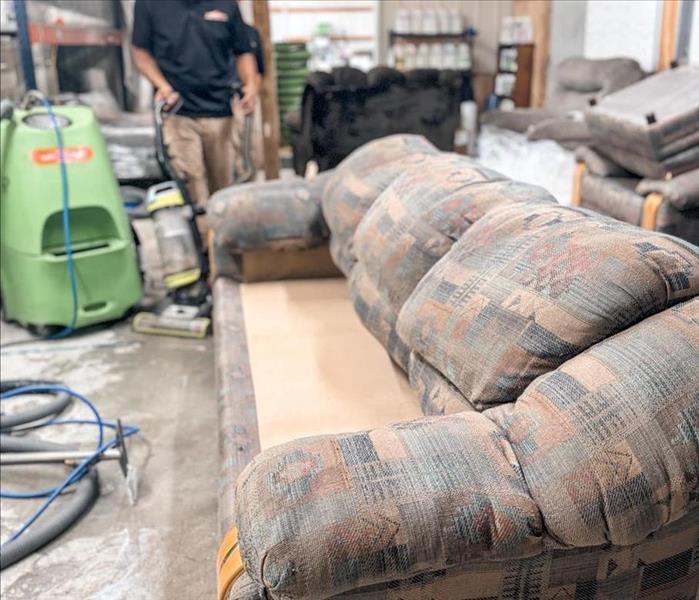 SERVPRO of Tulsa Hills/Sapulpa technician cleaning a couch.
SERVPRO of Tulsa Hills/Sapulpa technician cleaning a couch.
Keeping your upholstery clean is essential for maintaining a healthy and comfortable home environment. At SERVPRO of Tulsa Hills/Sapulpa, we offer professional upholstery cleaning services that can rejuvenate your furniture and extend its lifespan. Here’s why you should trust us with your upholstery cleaning needs.
The Importance of Professional Upholstery Cleaning
Regular upholstery cleaning is crucial for several reasons:
- Health Benefits: Over time, upholstery can accumulate dust, allergens, and bacteria. Our thorough cleaning process removes these contaminants, improving indoor air quality and reducing the risk of allergies and respiratory issues.
- Enhanced Appearance: Professional cleaning restores the original beauty of your furniture, removing stains, dirt, and grime that can make it look old and worn.
- Extended Lifespan: Regular maintenance and cleaning can significantly extend the life of your furniture, saving you money in the long run.
Why Choose SERVPRO for Upholstery Cleaning?
- Expert Technicians: Our team is trained and certified in upholstery cleaning techniques, ensuring your furniture is treated with care and expertise.
- Advanced Equipment: We use state-of-the-art cleaning equipment and eco-friendly products that are safe for your family and pets.
- Customized Cleaning Solutions: Every piece of furniture is unique. We tailor our cleaning methods to suit the specific fabric and condition of your upholstery, ensuring optimal results.
- Stain Removal: Our technicians are skilled in removing even the toughest stains, leaving your upholstery looking fresh and clean.
The Upholstery Cleaning Process
- Inspection: Our technicians begin by inspecting your upholstery to identify the type of fabric and any specific cleaning needs.
- Vacuuming: We thoroughly vacuum the upholstery to remove loose dirt and debris.
- Pre-Treatment: Stubborn stains and heavily soiled areas are pre-treated with specialized cleaning solutions.
- Deep Cleaning: Using advanced equipment, we deep clean the upholstery, extracting dirt, allergens, and contaminants.
- Rinsing and Drying: We rinse the upholstery to remove any cleaning residue and use powerful air movers to speed up the drying process.
- Final Inspection: We conduct a final inspection to ensure your satisfaction and the highest quality of cleaning.
Need Upholstery Cleaning? Call Us Today – 918-248-1440
At SERVPRO of Tulsa Hills/Sapulpa, we are committed to providing exceptional upholstery cleaning services. Our goal is to restore the beauty and comfort of your furniture, making it "Like it never even happened®." For professional upholstery cleaning, contact us today.
Large Format Drying Equipment
7/19/2023 (Permalink)
When a water line breaks in your home or business, it's only a matter of seconds before the water starts causing serious damage. Once SERVPRO of Tulsa Hills, Sapulpa removes the excess water, the floors and walls may appear dry, a quick inspection will reveal they are wet to the touch. Our Professionals will use room measurements, temperature, and relative humidity to determine the optimal number of air movers and dehumidifiers to dry your property. We’ll carefully monitor the progress using moisture meters until the materials return to acceptable drying goals. Professional and Industrial-grade dehumidifiers are used and help prevent secondary water damage like swelling and warping of floors, walls, and furniture. High-speed air movers are also utilized to create airflow across walls, carpets, pads, and furniture, which accelerates the evaporation of moisture.
Need Emergency Service?
Call Us 24/7
918-248-1440
We're always "Here to Help"
Specialty Cleaning Services
7/19/2023 (Permalink)
When was the last time your home or business was deep cleaned? SERVPRO of Tulsa Hills, Sapulpa understands maintaining a clean environment takes constant work and we are up for the job! Our certified technicians have the tools it takes to handle all your specialty cleaning projects. Most cleaning companies only have a couple of cleaning methods, but SERVPRO incorporates a variety of methods to assure your home, business, or property is properly cleaned and it looks "Like it Never Even Happened".
When we say SERVPRO cleans, we mean, carpet/upholstery cleaning, drapes/blinds/window treatments, ceiling/floors/walls, HVAC/air duct cleaning, biohazard/crime scene cleanup, document restoration, odor removal, vandalism/graffiti, and COVID-19 cleanings. Let us know if you think of anything else we can clean for you, we are always Here to Help.
Specialty Cleaning Services
7/19/2023 (Permalink)
When was the last time your home or business was deep cleaned? SERVPRO of Fort Smith understands maintaining a clean environment takes constant work and we are up for the job! Our certified technicians have the tools it takes to handle all your specialty cleaning projects. Most cleaning companies only have a couple of cleaning methods, but SERVPRO incorporates a variety of methods to assure your home, business, or property is properly cleaned and it looks "Like it Never Even Happened".
When we say SERVPRO cleans, we mean, carpet/upholstery cleaning, drapes/blinds/window treatments, ceiling/floors/walls, HVAC/air duct cleaning, biohazard/crime scene cleanup, document restoration, odor removal, vandalism/graffiti, and COVID-19 cleanings. Let us know if you think of anything else we can clean for you, we are always Here to Help.
Specialty Cleaning Services
7/19/2023 (Permalink)
When was the last time your home or business was deep cleaned? SERVPRO of Fort Smith understands maintaining a clean environment takes constant work and we are up for the job! Our certified technicians have the tools it takes to handle all your specialty cleaning projects. Most cleaning companies only have a couple of cleaning methods, but SERVPRO incorporates a variety of methods to assure your home, business, or property is properly cleaned and it looks "Like it Never Even Happened".
When we say SERVPRO cleans, we mean, carpet/upholstery cleaning, drapes/blinds/window treatments, ceiling/floors/walls, HVAC/air duct cleaning, biohazard/crime scene cleanup, document restoration, odor removal, vandalism/graffiti, and COVID-19 cleanings. Let us know if you think of anything else we can clean for you, we are always Here to Help.
Specialty Cleaning Services
7/19/2023 (Permalink)
When was the last time your home or business was deep cleaned? SERVPRO of Fort Smith understands maintaining a clean environment takes constant work and we are up for the job! Our certified technicians have the tools it takes to handle all your specialty cleaning projects. Most cleaning companies only have a couple of cleaning methods, but SERVPRO incorporates a variety of methods to assure your home, business, or property is properly cleaned and it looks "Like it Never Even Happened".
When we say SERVPRO cleans, we mean, carpet/upholstery cleaning, drapes/blinds/window treatments, ceiling/floors/walls, HVAC/air duct cleaning, biohazard/crime scene cleanup, document restoration, odor removal, vandalism/graffiti, and COVID-19 cleanings. Let us know if you think of anything else we can clean for you, we are always Here to Help.
Don't Let Heavy Rains Cause Sewer Backup
7/20/2022 (Permalink)
When there are heavy rains, an abundance of water and debris end up in municipal sanitary sewers, which can overload the sewer system. When there is more water than the sewer system can handle, excess water can flow backward into your home's sewer line and subsequently overflow into your basement. This is extremely common in our area.
Growing tree roots may pose another danger to your sewer line after storms. Tree roots may grow quickly over the summer months due to the increase in rain. Tree roots can pierce the pipes as they search for nutrients found in sewage. Within the system, roots continue to grow and may cause broken or blocked pipes.
Signs of a Clogged Sewer Pipe
- Slow drainage in toilets, showers, or sinks
- Bubbling noise as you flush toilets or shower/sink drains
- Another drain backs up when you flush toilets
- The smell of sewage (rotten eggs or sulfur)
- Lush, green spots in your yard above the septic tank or broken pipes
Sewer backups should be considered an emergency since the water may contain viruses, bacteria, and other microbes that can cause serious illness. SERVPRO of Sapulpa, Tulsa Hills has the specialized training and equipment to quickly and safely clean contaminants like sewage. We are available 24 hours a day, 365 days a year.
Large Format Drying Equipment
7/20/2022 (Permalink)
While all jobs are treated with the same importance, whether it is your Grandma's basement or you kid's Elementary School, not all jobs can be done with the same equipment. This is why at SERVPRO of Peoria we have specialized large format drying equipment to tackle large commercial jobs.
While we still use a lot of the same air movers, dehumidifiers, negative air machines, etc. there is other equipment we add for these large jobs. This equipment includes large trailer mounted generators, as well as large trailer mounted desiccant dehumidifiers.
This allows us to rapidly speed up the drying process in situations where time means everything. Often times, these commercial structures are large office spaces, factories, hospitals, schools, and many others facilities. All of them need to be open as quickly as possible, and our team uses our resources to make that happen.
If you have a loss at your facility, call SERVPRO of Sapulpa, Tulsa Hills at 918-248-1440 and allow us to get you back to pre loss condition as quickly as possible.






 24/7 Emergency Service
24/7 Emergency Service



